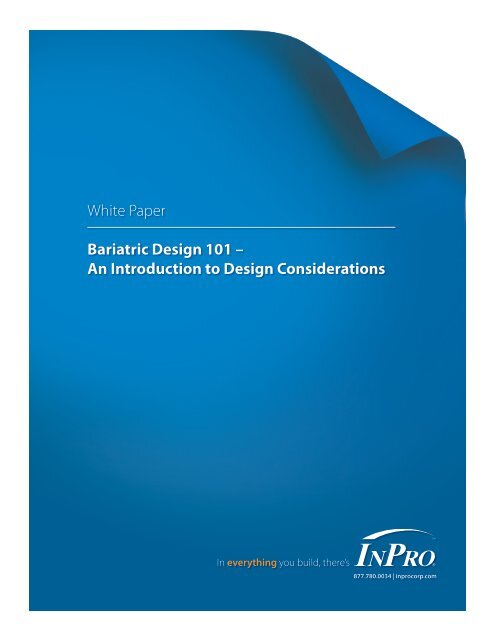White Paper Bariatric Design 101 - Healthcare Design Magazine
White Paper Bariatric Design 101 - Healthcare Design Magazine
White Paper Bariatric Design 101 - Healthcare Design Magazine
- No tags were found...
Create successful ePaper yourself
Turn your PDF publications into a flip-book with our unique Google optimized e-Paper software.
<strong>White</strong> <strong>Paper</strong>Proactive solutions addressed as early as possible in the design process are important. It is essential tothoroughly discuss and plan for the following critical issues:• A description of the patient population – physical and mental capacities, medical conditions• The types of procedures being performed and what equipment is required• How and where patients are transported (patient flow);• Dimensions and storage of equipmentTaking direction from evidence-based designWhile there is no evidence-based research specifically pointing to the field of bariatrics, we can look tomore general evidence based design guidelines for:Reducing Pain – Scientific studies have shown that exposing patients to nature can produce significantalleviation of pain. Other research also suggests that patients experience less pain when exposed to highlevels of daylight in their rooms. Finally, some research also supports displaying visual art with naturesubject matter helps reducing pain.Reducing slip/fall risk – In one Washington University School of Medicine study alone (2007), there were8,974 inpatient falls at just 9 hospitals tracked from 2001 to 2003. The slip-fall risk in healthcare continuesto be a major problem leading to injury, higher costs, liability and protracted recovery.Improving Patients’ Sleep – Sleep disruption and deprivation are common problems in healthcarebuildings; increasing acoustic performance with reduced reverberation time increased sleep quality.Reducing Patient Stress – Patient stress is a significant negative outcome in which bears many otherhealthcare negative consequences. A physical environment that contains stressful features makes apsychological patient state worse. Several experimental studies have shown that real or simulated viewsof nature can produce restoration from psychological stress in minutes.Reducing Depression – Many studies show that exposure to bright artificial light and daylight is effectivein improving mood and reducing depression, even for people affected by deep depression.Reducing Spatial Disorientation – Wayfinding problems in hospitals have an impact both on patientsand visitors, who can be stressed and disoriented. Improved signage can greatly reduce the stressassociated with moving through the healthcare facility.Improving Patient Privacy and Confidentiality – It is based on great evidence that the provisionof single-bed rooms increases patient privacy. Furthermore, providing private discussion rooms nearwaiting, admission, and reception areas may help avoiding breaches of speech privacy.Fostering Social Support – Some studies recommend the provision of stays and waiting rooms withcomfortable furniture arranged in a cluster, in order to encourage social interactions.Reducing Staff Injuries – The risk of caregiver injury is multiplied in bariatric settings. While properprocedures play a role, staff injuries can also be reduced through adequate space for movement, properequipment placement and appropriate fixtures and furniture.Decreasing Staff Stress – Stress is the most common cause of staff retirement. Environmental stressorsinclude noise, light, and multi-bed patient rooms. In fact, survey research shows that single-bed patientrooms are perceived to be less stressful for both family and staff than ones containing multi-beds.Increasing Staff Effectiveness – While most research is aimed at patients, there is a growing body ofevidence suggesting to improve hospital efficiency through making the jobs of staff easier. This can beachieved by spatial solution, environmental factors and technological devices.Increasing staff recruiting and retention – well-designed facilities that reduce stress, increase efficiencyand lower the risk of injury can be effective tools in recruiting, and lead to higher staff satisfaction.TM4http://www.natureworksllc.com/
<strong>Design</strong> factors for bariatric spaces<strong>White</strong> <strong>Paper</strong>This next section addresses the essential design factors for the various spaces in a bariatric or healthcarefacility, including:• Entrances and routes• Patient rooms and bathrooms• Diagnostic and treatment spaces• Lobbies and waiting areasWe’re basing much of this on the 2010 FGI Guidelines for <strong>Healthcare</strong> Facilities for the design of bariatriccare units, and the 2010 Patient Handling and Movement Assessments (PHAMA).Entrances and RoutesProviding adequate space and a safe environment begins at the outside of the clinic or hospital. Easyaccess with ramps and handrails, and wide enough to accommodate bariatric wheelchairs, walkers andother specialized conveyances, communicates to the patient that the facility is equipped to address andunderstand their medical needs.Establish an accessible path from the hospital entrance to all major departments by accommodating for a39” by 49” wide wheelchair (700 lbs capacity) with a 6’ turning radius, per the Facilities Guidelines Institute2010 revised guidelines.One of the most-significant design issues is associated with the patient accessing various areas of thehealthcare facility. Considerations: registration, physical rehabilitation, food service, common/family areas,emergency services, diagnostics, even the gift shop or vending areas.Factor door width and elevator capacity to make common areas more easily accessible for a patient,equipment and caregivers. Most hospital elevators have an average weight capacity of 2,000 to 3,000lbs, a capacity that may be exceeded when the weight of the bariatric patient, bed, transport staff, andspecialized equipment are added together.<strong>Bariatric</strong> Patient RoomMost examples of bariatric rooms currently in place are modifications to standard private or semiprivatebedrooms with a width (headwall-to-footwall dimension) of around 12 feet. The <strong>Bariatric</strong> Room <strong>Design</strong>Advisory Board (BRDAB) concluded that the optimal width should be 14 feet (13 feet was felt to be theminimum), and depth be 15 feet (corridor to exterior wall).Focus on the primary space drivers in these rooms, which include space for such specialized equipmentand furnishings as bariatric beds, resident lifts, bariatric wheelchairs, or oversized chairs.High-quality bariatric beds address the challenges inherent in bariatric care – patient comfort andmobility and mitigating the risk of injury to caregivers and patients. Such beds have built-in scales and canbe converted to chair position, a configuration to facilitate patient transfer.Other patient room space drivers include maneuverability needs for both the bariatric patient and for thecare team who are trying to safely and ergonomically assist the patient.One additional design consideration is the placement of cubicle track in relation to ceiling-mountedlift tracks. This is especially important for privacy curtain placements as the lift track runs from bed tobathroom.TM5http://bioplastics-cms.de/bioplastics/download/land_use_bioplasticsMAGAZINE_200904.pdf
Safely moving from bed to bathroom<strong>White</strong> <strong>Paper</strong><strong>Bariatric</strong> patients are likely to require assistance in transferring from a bed to chair or a chair to toilet.Depending on the patient’s ability to bear weight, level of cooperation, and upper body strength, twoto three caregivers may be needed to assist the patient. Even with the most observant and diligent care,patients will fall. Wide spacing between the bed and other obstacles will facilitate the care team’s effort inup righting the patient, and can mitigate the circumstance of the patient striking objects during a fall.According to a 2008 white paper by the Houston office of Page Southerland Page architects, the averagehospital patient room requires a 16 to 19 foot unassisted trip from bed to the toilet. Where possible innew construction, patient rooms should be designed to minimize the distance between the bed andbathroom. In one project – St. Luke’s Sugar Land Hospital in Texas – PSP was able to cut the trip distance inhalf.However, in all cases of new construction, renovation or retrofit, evidence-based design advocates arecalling for handrails to be installed from bed to bathroom to reduce slip-fall risk. At St. Luke’s Sugar Land,all rooms had a continuous handrail installed in the room, thus making all rooms handicap accessible.The bariatric patient bathroomSliding ICU-style doors are employed in some bariatric room settings. A sliding door that will yield a60-inch opening requires an overall opening of between 9 and 12 feet. The BRDAB preferred a pair ofunequal-leaf swinging doors--one leaf 42 inches wide, the other 18 inches--as the optimal solution. Thisconfiguration will yield the desired clear opening with the least overall width, thereby giving more wallspace to supporting functions.Oversized toilet seats are another preferred option. Toilet fixtures and sinks should be mounted to thefloor versus the wall, although care should be taken that floor-mounted sinks do not interfere withwheelchairs.Bathrooms should be sized to allow for staff assistance on two sides of the patient at the toilet andshower. Dispensers should be flush mounted to aid in clearance and safety. The shower stall should havea sufficient opening and space for unrestricted movement by the bariatric patient and, if necessary, staffperforming assists.Consider combing shower and toilet into a central bathing room. The BRDAB concluded that a room of atleast 45 square feet, with waterproof walls and floor, would be the ideal toilet/shower room. With strategicplacement of the fixtures and sloping of the floor to a drain, the entire room becomes the shower. Bynot having enclosing walls around the shower and using a shower curtain instead, caregivers can offermaximum assistance.The receptor should be tested for load bearing per ANSI Z124.1.2-2005. The receptor should also have afront transitional edge for easy access. Multiple grab bars should be available and rated for 1,000 poundseach. Also consider contrasting colors of grab pars for those who may have visual impairments.In addition, space for adaptive equipment such as wheelchairs and lifts is essential to plan for. Considertracking for ceiling lifts, accommodating ready access to shower, toilet and sink.Space design provides maximum safety and comfort - patient and care giver - and encourages somedegree of participation by the patient.TM
Treatment and diagnostic spaces<strong>White</strong> <strong>Paper</strong>Many of the same space and load requirements in the patient room carry over into diagnostic andtreatment spaces:• Should be designed as an easily accessible, private and comfortable area• Surgical and exam tables – 1,000 LBS rated• Table should be powered (up/down) for patient transfers• Scales – 1,800 LBS rated• Clear floor area - 150 SF minimum• Treatment table clearance –5 FT at sides and foot• Portable or built-in lift - 600 lbs. minimum• Furniture, plumbing fixtures, casework - floor mounted and rated at 1,000 LBSLobbies and waiting areasBasic room furnishings, such as chairs, may lack the size and weight capacity needed for bariatric patients.Standard chairs with arms are a particular problem in this regard, as there may not be enough spacebetween arms for patient use. Obese patients and visitors are often reluctant to sit for fear of not fitting instandard-sized furniture or breaking furniture.As mentioned earlier, there are two types of severely obese people--pear-shaped (weight concentratedbelow the waist in the hips and thighs) and apple-shaped (weight concentrated above the hips in thestomach and chest). This is important when considering seating, as pear-shaped people cannot abidechairs with arms, whereas apple-shaped bodies will do well in seating with or without arms. Offering bothtypes of seating would service the general population as well as the severely obese.A seat too low, the patient may have trouble standing without assistance. The arms must have agrasp point on the front of the arm, providing a stable platform or push point. A larger seat widthaccommodates the greatest number of patients. A seat that pitches forward assists the patient with a safeexit from the chair.The need for increased interior protectionBefore we leave the topic of designing specific spaces in a bariatric facility or treatment area, we want totalk briefly about protecting surfaces.We have already stated that there is the potential for greater wear and tear in bariatric spaces due tohigher loads and the movement of specialized equipment needed for the care of obese patients. It standsto reason that wall and door protection should receive special attention and consideration to minimizedamage and maintain a clean, fresh appearance.We’ll start with wall protection. Wall cladding should be considered in either a wainscoting or full-wallapplication. And we would suggest that thicker rigid cladding be chosen.Handrails can act as wall guards, so impact resistance is critical. In addition, ratings for load bearing shouldbe high, and should have the proper grip radius for both patient comfort and safety.Wall guards complete the wall protection package by absorbing impact from wheelchairs and lowerequipment surfaces, such as carts, gurneys, and diagnostic equipment.TM
<strong>White</strong> <strong>Paper</strong>Two options for wall construction in bariatric installations are:1. 20 gauge metal framing with vertical studs spaced 16” on center. Horizontal metal strapping tobe 16 gauge x 6” wide. A layer of ½” plywood to be mechanically fastened to the metal framingfollowed by 5/8” gypsum board.2. 20 gauge metal framing with vertical studs spaced 16” on center. Horizontal wood strapping to be2x6 board. A layer of ½” plywood to be mechanically fastened to the metal framing followed by 5/8”gypsum board.It is almost a given that a simple tape-on corner guard is not going to be up to the task of cornerprotection in bariatric spaces. Selection should be based on impact resistance, with particular attentionpaid to the design and construction of the inner retainer.Patients and equipment moving through doorways can lead to heavy wear on the door surface, jamb,handle and frame. Protection options include fully clad doors, door frame guards, kickplates and handleprotectors.Conclusions• Obesity has become an alarming epidemic with enormous implications for our healthcare system.• Respecting patient dignity and delivering optimal clinical care are primary issues, as are establishingprocedures for safeguarding the health and well-being of these patients and their caregivers.• <strong>Design</strong> is a critical tool in improving long-term clinical outcomes for bariatric patients.• <strong>Design</strong>ers must focus on appropriate facilities and space, proper equipment and furnishings in bariatriccare facilities.• The probability of greater wear and tear call for stepped-up interior protection for walls, corners, doorand door frames.References and suggested readingChastain, Barbara, and Chisholm, Phil. (2008). The shortest path to recovery. Page Southerland Page. Retrieved from:http://www.pspaec.com/perspectives/The_Shortest_Path.pdfCohen, Martin H., et al. (April 2010). Patient handling and movement assessments: A white paper. Facilities GuidelinesInstitute.Facilities Guidelines Institute. (2010). Guidelines for design and construction of healthcare facilities.Facilities Guidelines Institute. (2010). Patient Handling and Movement Assessments (PHAMA): A <strong>White</strong> <strong>Paper</strong>.Kroll, Karen. (January 2005.) Evidence-based design in healthcare facilities. Building Operating Management.Lawson, Bryan. (2005). Evidence-based design in healthcare. Business Briefing: Hospital Engineering & FacilitiesManagement.Malone, Eileen and Dellinger, Barbara. (May 2011). Furniture design features and healthcare outcomes. The Center forHealth <strong>Design</strong>.Pelczarski, Kathryn. (March 2007). Basic concerns in bariatrics. <strong>Healthcare</strong> <strong>Design</strong> <strong>Magazine</strong>.Special handling and movement challenges related to bariatrics. (August 2007). Retrieved from: http://www.visn8.va.gov/patientsafetycenter/safePtHandling/<strong>Bariatric</strong>sToolkit.pdfWignall, Doug. (March 2008). <strong>Design</strong> as a critical tool in bariatric care. Journal of Diabetes Science and Technology,2(2), 263-267.Williams, David S. (March 2008). <strong>Design</strong> with dignity: The design and manufacture of appropriate furniture for thebariatric patient population. <strong>Bariatric</strong> Nursing and Surgical Patient Care. 3(1), 39-40.TM
InPro Corporation – Based in Muskego, Wisconsin, InPro is the nation’s premier manufacturerof building products, offering the most choices and best service in door and wall protection,decorative surfaces, expansion joint systems, privacy systems/soft goods and signage &wayfinding. InPro products are used in the healthcare, senior living, hospitality, education, andgovernment sectors.In January 2010, InPro became the first company in its industry to create virtually its entireproduct offering in manageably sized Building Information Modeling (BIM) objects. InPro’s BIMlibrary is compatible with Autodesk ® Revit ® . Visit www.inprocorp.com/bimready to learn more.The company leads the industry with the first biopolymer wall protection – InPro’s exclusive G2Blend® made from BioPolyPETG+ material containing both a biopolymer and recycled content.For more information about InPro Corporation,visit inprocorp.com or call 877.780.0034.inprocorp.comS80 W18766 Apollo DriveP.O. Box 406Muskego, WI 53150 USA800.222.5556 toll-free888.715.8407 toll-free fax262.679.5521 international262.679.5524 international fax© 2012 InPro Corporation












